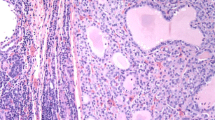Abstract
Introduction
The follicular variant of papillary thyroid carcinoma (FVPTC) is the most common histologic subtype of papillary thyroid carcinoma (PTC). However, it is still controversial whether FVPTC should behave differently from classical PTC (CPTC). The present study aimed at evaluating any potential difference in clinicopathologic features and long-term outcome of FVPTC as compared with CPTC.
Patients and Methods
Of 568 patients with PTC managed from 1973 to 2004, 308 were shown to have CPTC (54.2%) and 67 (11.8%) FVPTC after histologic review. The mean (± SD) follow-up period was 11.3 (± 8.9) years. The two groups were compared in terms of clinicopathological features, treatment received, and outcome regarding recurrence and disease-specific survival.
Results
There was no difference in age and gender ratio between the CPTC and FVPTC patients. Both groups had similar tumor characteristics in terms of tumor size, presence of multifocality, capsular invasion, lymphovascular permeation, and perineural infiltration. However, FVPTC patients had significantly fewer histologically confirmed cervical lymph node metastases (P = 0.027) and extrathyroidal involvement (P = 0.005). The proportion of bilateral resection, adjuvant radioactive iodine, and lymph node dissection did not differ significantly between the two groups. The FVPTC patients had a more favorable tumor risk by DeGroot classification (P = 0.003) and MACIS (Metastasis, Age, Completeness of excision, Invasiveness, and Size) score (P = 0.026). The 10- and 15-year actuarial disease-specific survivals did not differ significantly between FVPTC and CPTC patients (96.2% versus 90.7% and 96.2% versus 89.1%, respectively).
Conclusions
Although patients with FVPTC had more favorable clinicopathologic features and a better tumor risk group profile, their long-term outcome was similar to that of CPTC patients.


Similar content being viewed by others
References
Tielens ET, Sherman SI, Hruban RH, et al. Follicular variant of papillary thyroid carcinoma: a clinicopathologic study. Cancer 1994;73:424–431
Ortiz Sebastian S, Rodriguez Gonazles JM, Parilla Paricio P, et al. Papillary thyroid carcinoma: prognostic index for survival including the histological variety. Arch Surg 2000;135:272–277
Zidan J, Karen D, Stein M, et al. Pure versus follicular variant of papillary thyroid carcinoma: clinical features, prognostic factors, treatment, and survival. Cancer 2003;97:1181–1185
Crile GJ, Hazard JB. Relationship of the age of the patient to the natural history and prognosis of carcinoma of the thyroid. Ann Surg 1953:138:33–38
Passler C, Prager G, Scheuba C, et al. Follicular variant of papillary thyroid carcinoma: a long-term follow-up. Arch Surg 2003;138:1362–1366
Burningham AR, Krishnan J, Davidson BJ, et al. Papillary and follicular variant of papillary carcinoma of the thyroid: initial presentation and response to therapy. Otolaryngol Head Neck Surg 2005;132:840–844
Carcangiu ML, Zampi G, Pupi A, et al. Papillary carcinoma of the thyroid: a clinicopathologic study of 241 cases treated at the University of Florence, Italy. Cancer 1985;55:805–828
Falvo L, Catanio A, D’Andrea V, et al. Prognostic importance of histologic vascular invasion in papillary thyroid carcinoma. Ann Surg 2005;241:640–646
Lloyd RV, DeLellis RA, Heitz PU, et al. World Health Organization Classification of Tumours: Pathology and Genetics of Tumours of Endocrine Organs, IARC (International Agency for Research on Cancer) Press, Lyons, France, 2004
Lloyd RV, Erickson LA, Casey MB, et al. Observer variation in the diagnosis of follicular variant of papillary thyroid carcinoma. Am J Surg Pathol 2004;28:1336–1340
Lo CY, Chan WF, Lam KY, et al. Optimizing the treatment of AMES high-risk papillary thyroid carcinoma. World J Surg 2004;28:1103–1109
Cady B, Rossi R. An expanded view of risk-group definition in differentiated thyroid carcinoma. Surgery 1988;104:947–953
UICC (International Union Against Cancer). TNM Classification of Malignant Tumor, 5th ed. (Editors: Sobin LH, Wittlekind C), New York, Wiley-Liss, 1997
DeGroot LJ, Kaplan EL, McCormick M, et al. Natural history, treatment, and course of papillary thyroid carcinoma. J Clin Endocrinol Metabol 1990;71:414–424
Hay ID, Bergstrath EJ, Goellner JR, et al. Predicting outcome in papillary thyroid carcinoma: development of a reliable prognostic scoring system in a cohort of 1779 patients surgically treated at one institution during 1940 to 1989. Surgery 1993;114:1056–1058
LiVolsi VA. Pure versus follicular variant of papillary thyroid carcinoma: clinical features, prognostic factors, treatment, and survival. Cancer 2003;98:1997; author reply 1997–1998
Baloch ZW, LiVolsi VA. Follicular-patterned lesions of the thyroid: the bane of the pathologist. Am J Clin Pathol 2002;117:143–150
Zhu Z, Gandhi M, Nikiforova MN, et al. Molecular profile and clinical-pathologic features of the follicular variant of papillary thyroid carcinoma: an unusually high prevalence of ras mutations. Am J Clin Pathol 2003;120:71–77
Trovisco V, de Castro IV, Soares P, et al. BRAF mutations are associated with some histiotypes of papillary thyroid carcinoma. J Pathol 2004;202:247–251
Lo CY, Lam KY, Leung PP, et al. High prevalence of cyclooxygenase 2 expression in papillary thyroid carcinoma. Eur J Endocrinol 2005:152:545–550
Author information
Authors and Affiliations
Corresponding author
Additional information
Free paper presentation in International Surgical Week 2005, Durban, South Africa 21–25 August, 2005.
Rights and permissions
About this article
Cite this article
Lang, B.HH., Lo, CY., Chan, WF. et al. Classical and Follicular Variant of Papillary Thyroid Carcinoma: A Comparative Study on Clinicopathologic Features and Long-term Outcome. World J. Surg. 30, 752–758 (2006). https://doi.org/10.1007/s00268-005-0356-7
Published:
Issue Date:
DOI: https://doi.org/10.1007/s00268-005-0356-7



